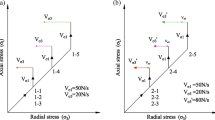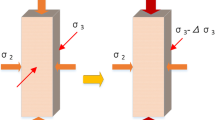Abstract
One of the key issues in protective seam mining is the pressure relief and permeability improvement effect. In this paper, the results of X-ray CT scanning experiments and permeability experiments using reconstituted coal specimens subjected to the same stress path and the same effective confining pressure (confining pressure minus pore pressure) are combined using the stress–strain relationship to study the damage to reconstituted coal specimens and its influence on permeability during the unloading process. When the effective confining pressure (σ 3 − p) is unloaded from 8 to 6 MPa and the deviatoric stress increases, the damage variables will increase by 0.0351 and 0.084, respectively, compared with the unloading point under the fixed axial displacement with unloading confining pressure (FADUCP) and fixed deviatoric stress with unloading confining pressure (FDSUCP) stress paths. At the same time, the permeability increased by 1.7 and 16.7 %, respectively. Therefore, the damage variable and permeability increased notably little in this process. After the effective confining pressure is unloaded to approximately 5 MPa, together with the decrease in the deviatoric stress, the growth of the damage variable and permeability begins to accelerate. In addition, the relative decrease in the deviatoric stress with appearing damage cracks, and the relative increase in permeability with the same amount of effective confining pressure being unloaded, shows that the damage to specimens under the FDSUCP stress path is larger than that from the FADUCP stress path.





















Similar content being viewed by others
References
Bobet A, Einstein HH (2010) Fracture coalescence in rock-type materials under uniaxial and biaxial compression. Int J Rock Mech Min Sci 35:863–888
Brace WF, Walsh JB, Frangos WT (1968) Permeability of granite under high pressure. J Geophys Res 73:2225–2236
China State Administration of Work Safety (2009) MT/T 1087-2008 test methods for proximate analysis of coal by instruments. Beijing (in Chinese)
Evans B, Wong TF (1992) Fault mechanics and transport properties of rocks. Academic Press, New York
Feng XT, Chen SL, Zhou H (2004) Real-time computerized tomography (CT) experiments on sandstone damage evolution during triaxial compression with chemical corrosion. Int J Rock Mech Min Sci 41:181–192
Guo H, Yuan L, Shen BT, Qu DD, Xue JH (2012) Mining-induced strata stress changes, fractures and gas flow dynamics in multi-seam longwall mining. Int J Rock Mech Min Sci 54:129–139
Jasinge D, Ranjith PG, Choi SK, Kodikara J, Arthur M, Li H (2009) Mechanical properties of reconstituted Australian black coal. J Geotech Geoenviron Eng 135:980–985
Jasinge D, Ranjith PG, Choi SK (2011) Effects of effective stress changes on permeability of Latrobe valley brown coal. Fuel 90:1292–1300
Karacan CÖ, Esterhuizen GS, Schatzel S, Diamond WP (2007) Reservoir simulation based modeling for characterizing longwall methane emissions and gob gas venthole production. Int J Coal Geol 71:225–245
Kawakata H, Cho A, Yanagidani T, Shimada M (1997) The observations of faulting in westerly granite under triaxial compression by X-ray CT scan. Int J Rock Mech Min Sci 34:151.e1–151.e12
Lama RD, Bodziony J (1998) Management of outburst in underground coal mines. Int J Coal Geol 35:83–115
Li SP, Wu DX, Xie WD, Li YS, Wu ZY, Zhou G, Zhao HY (1997) Effect of confining pressure, pore pressure and specimen dimension on permeability of Yinzhuang sandstone. Int J Rock Mech Min Sci 34:175
Liu YK, Zhou FB, Liu L, Liu C, Hu SY (2011) An experimental and numerical investigation on the deformation of overlying coal seams above double-seam extraction for controlling coal mine methane emissions. Int J Coal Geol 87:139–149
Majdi A, Hassani FP, Nasiri MY (2012) Prediction of the height of destressed zone above the mined panel roof in longwall coal mining. Int J Coal Geol 98:62–72
Otani J, Mukunoki T, Obara Y (2000) Application of X-ray CT method for characterization of failure in soils. Soils Found 40:113–120
Palchik V (1989) Analytical and empirical prognosis of rock foliation in rock masses. J Coal Ukraine 7:45–46
Palchik V (2003) Formation of fractured zones in overburden due to longwall mining. Environ Geol 44:28–38
Palchik V (2005) Localization of mining-induced horizontal fractures along rock layer interfaces in overburden: field measurements and prediction. Environ Geol 48:68–80
Palmer I, Mansoori J (1998) How permeability depends on stress and pore pressure in coalbeds: a new model. SPE Reserv Eval Eng 1:539–544
Peng SJ, Xu J, Yang HW, Liu D (2011) Experimental study on the influence mechanism of gas seepage on coal and gas outburst disaster. Saf Sci 50:816–821
Ranjith PG, Jasinge D, Choi SK, Mehic M, Shannon B (2010) The effect of CO2 saturation on mechanical properties of Australian black coal using acoustic emission. Fuel 89:2110–2117
Shi JQ, Durucan S (2003) Changes in permeability of coalbeds during primary recovery—part 1: model formulation and analysis. Proceedings of the 2003 International Coalbed Methane Symposium. University of Alabama, Tuscaloosa, Paper 0341
Shi JQ, Durucan S (2003) Changes in permeability of coalbeds during primary recovery—part 2: model formulation and analysis. Proceedings of the 2003 International Coalbed Methane Symposium. University of Alabama, Tuscaloosa, Paper 0342
Somerton WH, Soylemezocjlu IM, Dudley RC (1975) Effect of stress on permeability of coal. Int J Rock Mech Min Sci Geomech Abstr 12:129–145
State Bureau of Quality Technology Supervision of the People’s Republic of China (1998) Determination of maceral group composition and minerals in coal, China. Standard Press, Beijing (in Chinese)
Wang L, Cheng YP (2012) Drainage and utilization of Chinese coal mine methane with a coal-methane co-exploitation model: analysis and projections. Resour Policy 37:315–321
Wang SG, Elsworth D, Liu JS (2011) Permeability evolution in fractured coal: the roles of fracture geometry and water-content. Int J Coal Geol 87:13–25
Wang SG, Elsworth D, Liu JS (2013) Permeability evolution during progressive deformation of intact coal and implications for instability in underground coal seams. Int J Rock Mech Min Sci 58:34–45
Wong RHC, Chau KT (1998) Crack coalescence in a rock-like material containing two cracks. Int J Rock Mech Min Sci 35:147–164
Yang GS, Xie DY, Zhang CQ (1998) Quantitative analysis of CT distribution law of rock damage. Chin J Rock Mech Eng 17:279–285 (in Chinese)
Yang TH, Xu T, Tang CA, Shi BM, Yu QX (2011) Stress-damage-flow coupling model and its application to pressure relief coal bed methane in deep coal seam. Int J Coal Geol 86:357–366
Yang W, Lin BQ, Qu YA, Zhao S, Zhao C, Jia LL, Zhao WQ (2011a) Mechanism of strata deformation under protective seam and its application for relieved methane control. Int J Coal Geol 85:300–306
Yang W, Lin BQ, Qu YA, Li ZW, Zhai C, Jia LL, Zhao WQ (2011b) Stress evolution with time and space during mining of a coal seam. Int J Rock Mech Min Sci 48:1145–1152
Yao YP, Zhou SN (1998) The mechanical property of coal containing gas. J China Univ Min Technol 1:1–7
Yin GZ, Wang DK, Zhang DM, Wang WZ (2008) Test analysis of deformation characteristics and compressive strengths of two types of coal specimens containing gas. Chin J Rock Mech Eng 28:410–417 (in Chinese)
Zhou XP, Zhang YX, Ha QL (2008) Real-time computerized tomography (CT) experiments on limestone damage evolution during unloading. Theor Appl Fract Mech 50:49–56
Acknowledgments
This research was supported by the Natural Science Foundation for the Youth of China (No. 51204173), the National Basic Research Program of China (973 Program, No. 2011CB201204) and the Natural Science Foundation for the Youth of China (No. 41202118).
Author information
Authors and Affiliations
Corresponding author
Rights and permissions
About this article
Cite this article
Chen, HD., Yuan-Ping, C., Zhou, HX. et al. Damage and Permeability Development in Coal During Unloading. Rock Mech Rock Eng 46, 1377–1390 (2013). https://doi.org/10.1007/s00603-013-0370-2
Received:
Accepted:
Published:
Issue Date:
DOI: https://doi.org/10.1007/s00603-013-0370-2




